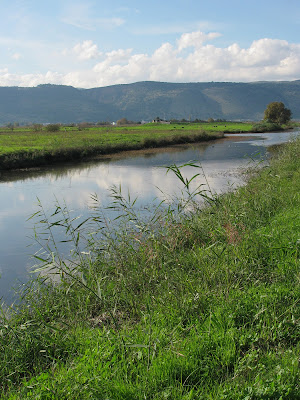The Hula Lake was once a large swamp that was dried in the early days of the State of Israel and then flooded again when numerous agricultural and ecological problems occurred. Israel is located on one of the main bird migration routes between Europe and Africa, and the lake and surrounding reserve hosts millions of birds in the migration seasons. Storks, cranes, pelicans and kingfishers are a familiar sight and you can also see coypu (nutria) and water buffalo roaming wild.
In December and January, just when we visited, the cranes are fed in the crane observation point, below. The cranes are huge and noisy and fill the air with loud honks and hoots. Every year 100,000 of these birds fly from Russia down to Africa to spend the winter. A quarter of these cranes winter in the Hula Valley and have become a threat to the peanut crops grown extensively in the fields across the valley. A solution was found to supply the cranes with food, whilst protecting the crops in the area, at a cost of over 2 million shekels per year. We each paid a 3 shekels fee at the Visitors Centre to help lighten the burden of the feeding costs.
At the entrance to the reserve we hired a multi-passenger bicycle (you can also hire golf carts or walk), intending to pedal around the lake and surrounding woodland. The 8.5 km route is levelled and paved but we hadn't counted on just how heavy the bike would be with three adults sitting on it (the boys had gone off on their own). In the end one of us ended up walking just to lighten the load! However, this didn't spoil our fun. The Hula Lake is a beautiful and well planned reserve with hides to watch the birds from and a large deck on the edge of the lake. We spent a few wonderful hours getting close to nature and watching the birds fly by.
One day I hope to go back for a night tour of the reserve, to look out for the jungle cats, bats and owls. I simply love the place. But next time, as on our first visit, I'll be renting a bike just for myself.








































































